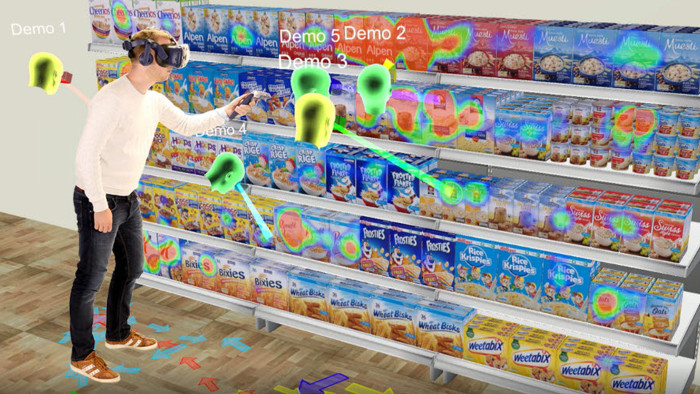孤独缓解:眼动跟踪观众观看酒吧视频
Summary
这项研究提出了一个激活匹配模型,研究当一个孤独的观众观看理性和情感诉求的狂轰滥炸视频时,孤独是如何减轻的。该协议使用眼动追踪来记录持续时间和固定性,在内容和攻击中安抚情感需求时,它考虑到了满足程度。
Abstract
研究人员通常根据传统媒体的假设来理论化媒体曝光。但是,一种新的交互式视频观看格式(在此例中是将观看者的评论叠加在视觉内容上)的狂轰滥炸视频,对过去的观点提出了挑战。本研究提出了一个激活和匹配满意度模型,以研究孤独的人的观察行为,并挑战以前的主张。它提出了一个协议,通过结合眼动追踪和自我报告措施来检查孤独者如何使用炮击视频的机制。眼动追踪记录了受众的意识和潜意识实时观察行为,并允许根据理性和情感内容推断分配的认知资源量。自我报告衡量获得的满意度。总体而言,这些措施的结果支持了关于孤独者及其狂轰滥炸视频观看行为的激活和匹配满意度模型。将讨论含义。
Introduction
眼动追踪技术
眼睛通常被称为心灵的窗户1,2。80%的人类信息摄入是视觉上获得的3。自19世纪以来,人们开始通过直接观察参与者的眼动来研究人类的心理活动。迈尔斯发明了窥视孔,在参与者阅读4时进行观察。在研究中,实验者坐在参与者的对面,通过阅读材料中间的一个小洞观察参与者的眼睛运动。自那时以来,技术有了很大的进步。目前,最先进的眼动跟踪设备主要集中在电流记录、磁感应和光学记录上,其中包括角膜反射和虹膜反射方法5、6、7。今天广泛流行的非侵入性特征使眼动记录更加自然,提高了生态有效性。今天,眼动技术通常是指使用计算机控制的眼动追踪来记录和分析参与者的眼睛定位和眼睛运动的形式,在观看视觉材料。
多年来,许多关于眼动的理论观点已经成熟。其中包括视觉缓冲器处理模型、准处理模型、E-Z读卡器模型、立即处理模型和眼心处理模型8、9、10。立即处理模型认为,所有级别的查看内容的处理不会延迟,而是实时进行。思维处理模型侧重于文本信息,认为只要一个人在处理一个单词,就会看它。换句话说,一个过程这个词正是一个人正在看的词。单词的处理时间是参与者眼睛的总固定时间。
人眼运动有三种基本类型:固定、囊和追求运动8、11、12。固定持续时间和固定计数通常反映参与者对所查看内容施加认知资源的程度。Saccade 指的是从一个注视点到另一个注视点的运动。追溯囊可以用作编码过程中处理复杂程度的指标。回归囊表示在关键区域的第一次凝视后对区域进行更深入的处理,反映了该区域中内容的难度或兴趣。追求动作通常是在视觉噪音时进行的,眼睛会寻找一个感兴趣点。
另一方面,我们也可以测量瞳孔大小和闪烁频率;两者都反映了人们的心理活动13,14,15。例如,学生规模与特定任务难度、动机、兴趣、态度和疲劳之间是有关系。目前,学生规模与情感价值的关系尚不清楚。然而,如果研究人员将瞳孔大小与其他指标(如脑电图(EEG)相结合,其准确性将大大提高17。对于眨眼指标,根据享乐闪烁假说,眨眼频率的降低通常与快乐的情绪想法有关,而眨眼频率的增加与不愉快的情绪状态18有关。
眼动追踪技术的应用极为广泛,包括阅读策略、视觉信息处理、强迫行为,甚至艺术意图。在阅读领域的应用是最成熟的。在通信中,眼动追踪在新闻消费研究和广告效果研究中非常有用。例如,大量的眼动实验探索了广告19、20中的外源和内生因素,前者探索了广告的物理特征,如大小、图案、颜色、位置、独创性和重复演示21、22,后者探索了产品参与、产品动机、先验知识和品牌熟悉度等个别因素23、24、25、26、27。
此外,眼动追踪技术还广泛应用于许多其他领域,如人机交互和可用性研究28、29、30、31;技能转移32;幼儿及儿童发展研究 33、34、35、36;营销和在线消费者行为研究37、38、39;和包装设计40,41,等等。
除了单独使用外,眼动追踪还经常与其他多式联运测量技术相结合。例如,研究人员可以将眼动数据与其他生理指标(如脑电图、皮肤电反应、心率、皮肤温度、面部表情等)相结合。这样,用户对不同种类的信息的情绪反应就可以更有效地研究。
眼动技术也可以集成到其他技术中。例如,它正与增强现实技术30一起使用。目前,眼动技术与虚拟现实(VR)技术的融合值得关注。一方面,这种集成可以促进VR相关设备的快速发展。例如,大多数 VR 设备的图形处理单元 (GPU) 负担过重,消耗大量能源。眼动追踪技术可以实时检测观众的固定点。VR 设备只需专注于渲染此区域,而忽略其他区域。这可显著降低功耗和 GPU 渲染负载。另一方面,这种组合可以增强其交互功能,提高VR用户的沉浸和参与度。例如,玩家可以使用眼部运动而不是手来完成游戏43中的操作。此外,研究人员还可以在模拟环境中实施眼动测试。例如,在消费者行为研究中,研究人员不需要将受试者带至真正的购物中心或使用真正的产品,而是需要在虚拟研究场景中测试它们,如图 1 所示。

图 1:虚拟研究场景请单击此处查看此图的较大版本。
栏杆视频
炮击是一个源自军队的术语。为了拦截移动目标,使用多门火炮射击,并在移动目标44之前形成由高密度弹丸组成的幕布。术语”攻击”用于视频观看,用于描述特定视频的受众在观看视频时在视频屏幕上评论和显示此类评论的格式和现象,从而形成注释墙幕,如图2 所示。这种互动和评论的形式也被称为叠加注释45,46。在日本的”尼科尼科”视频网站上首次出现的巴奇视频。中国最受欢迎的网站是AcFun(A站,www.acfun.cn站)和比利比利(B站,www.bilibili.com)。中国许多其他流媒体视频网站,如优酷、腾讯、乐视和易来,也增加了发送和观看功能。段视频吸引了许多中国观众,许多学科的研究人员也因此备受关注。

图2:评论墙幕请点击这里查看这个数字的较大版本。
攻击视频的观看者可以通过评论来观看和与他人互动,以满足一些心理需求。此类视频的受众在年龄、背景和兴趣方面可能具有相似性,因此他们可能会形成认同感和归属感。例如,有研究表明,AcFun和Bilibili是”二重奏元素”流派爱好者的家,其观众主要是17至25岁,47岁,48岁。这两个网站建立了一个极其严格的会员审查制度,因为会员身份只有在通过回答诸如”巴特勒飓风中数千名捍卫者的女主角 的高度是多少?””戈农在拉姆战役中派出了 多少艘巡洋舰?”这样的标准基本上把大多数想”入侵”这个群体的观众”异质”化了。
与这项研究相关,炮击视频创造了一种人群观看的感觉,这是特别有意义的孤独的人。由于炮击的内容与情节高度相关,评论是即时的反应,它给观众一个错觉,观看与别人,即使他们可能单独观看身体。这种陪伴感已被证明可以减轻孤独感。
条带视频也提供不同种类的娱乐,因为观众不仅消费,而且通过混合有时严肃的电影制作与有趣的戏剧创建视频内容。被攻击的观众也可以找到一个远离现实的避难所50,51,他们可以发泄他们的焦虑,在一个安全的环境中进行情感宣泄52,或展示他们的个性,通过引起他人的注意来展示自恋,甚至绕过现实世界中的顺从规范53。
孤独的观众的观看机制
酒吧视频观看是一个理想的平台,研究媒体使用和孤独,其情感支持提供场地。在这项研究中,研究人员发现以前对媒体曝光的概念化是不够的,因此提供了一个激活和匹配满意度模型(AMSM)来解释观看攻击的心理基础,尤其是孤独者。在以前的研究中,有两种观点解释了媒体的使用。缺陷范式认为,孤独者由于缺乏陪伴,在观看、寻求陪伴和补偿孤独时,会将更多的认知资源投入到炮击内容上。全球使用范式认为,媒体使用很普遍,它满足了一般和人际需求。因此,无论情绪状态如何,所有观众都会关注炮击,他们获得不同的满足感。然而,AMSM认为情感内容有助于激活孤独受众的人际需求,他们会主动寻找互动和人际沟通元素,如观看过程中的内容,并更加关注这些要素。这些元素满足他们情感需求的程度决定了他们获得的满足程度。
为了了解孤独者观看视频的机制,人们需要知道孤独者对不同媒体内容投入的认知资源量,以及他们如何满足自己的需求。但是,传统的参与性报告方法无法可靠地获得此类数据。认知资源配置有意识和潜意识。这是一个很高的顺序,观众阐明哪些部分的内容,他们投入更多的认知资源。为此,除了测量与观看过程的相应满意度外,还需要一种合适的研究方法来记录观看过程,并区分对内容不同部分的关注程度。
出于这些原因,该项目跟踪参与者的眼动,作为注意力的测量和认知资源分配的程度。后续 Likert 量表问题旨在衡量参与者的曝光满意度。眼动追踪是一种非侵入性技术,具有高时空分辨率,允许记录,而参与者处理连续的视觉刺激,没有分心55,56。在这项研究中,持续时间和固定计数用作注意力的度量。持续时间是指注意的长度,固定计数是指视频材料特定区域的凝视次数。这两项眼动指标都被证明是有效的处理彻底性指标,反映了个人分配的认知资源57,58。例如,凝视概率的结果允许研究人员推断视频中对参与者重要的属性。对于自我报告的措施,研究人员使用7点的喜欢量表,在观看后立即询问和回答。
根据先前解释的观点,研究人员设计了一个2(观众类型)x2(广告吸引力)x2(炮击)混合实验研究,并假设正常和孤独的参与者对炮击视频的关注量。受众类型(孤独和正常)是一个介于两者之间的因素。广告吸引力有两个层次,无论是情感广告还是理性广告。炮击也有两个级别, 表示视频, 要么有炮击或没有。最后两个在主题因素范围内。一般假设是,孤独的观众会更关注情感广告而不是理性广告,他们会更关注炮击而不是非抨击,而对于普通观众来说,没有这种差异。满意度评级遵循相同的模式。陈等人的原论文 详细叙述了所有这些假设。
Protocol
Representative Results
Discussion
在这项研究中,眼动追踪技术和自我报告相结合,以测试建议的 AMSM 模型的有效性。先前的研究主要利用自我报告来探索孤独与媒体使用之间的关系,而媒体使用受参与者表达能力的摆布。这些离线方法无法理解心理过程,同时观看炮击视频。在这项研究中,眼动追踪技术被用来记录持续时间和固定,以便研究人员能够可靠地推断出参与者在不同视频内容上投入多少认知资源。该技术是非侵入性?…
Divulgaciones
The authors have nothing to disclose.
Acknowledgements
这项研究得到了国家社会科学基金(19ZDA332)的”新时期社会治理媒体与创新模式的深度融合”项目的支持;中国广东省自然科学基金博士创业基金(2017A03030310536);和中央大学基础研究基金(19JNQM04)。作者感谢院长/教授志振荣对眼动追踪实验室的支持和投资。
Referencias
- Obersteiner, A., Tumpek, C. Measuring fraction comparison strategies with eye-tracking. ZDM. 48 (3), 255-266 (2016).
- Rauthmann, J. F., Seubert, C. T., Sachse, P., Furtner, M. R. Eyes as windows to the soul: Gazing behavior is related to personality. Journal of Research in Personality. 46 (2), 147-156 (2012).
- Feng, Z. . Eye-movement Based Human-Computer Interaction. , 45-58 (2010).
- Miles, W. The peep-hole method for observing eye movements in reading. The Journal of General Psychology. 1 (2), 373-374 (1928).
- Shi, J., Xu, J. Research progress on eye tracking technology. Optical Instruments. 41 (3), 87-94 (2019).
- Larsson, L., Nystrorm, M., Andersson, R., Stridh, M. Detection of fixations and smooth pursuit movements in high-speed eye-tracking data. Biomedical Signal Processing & Control. 18, 145-152 (2015).
- Yarbus, A. L. . Eye movement and vision. , (1967).
- Holmqvist, K., et al. . Eye tracking: A comprehensive guide to methods and measures. , (2011).
- Schindler, M., Lilienthal, A. J. Domain-specific interpretation of eye tracking data: towards a refined use of the eye-mind hypothesis for the field of geometry. Educational Studies in Mathematics. 101 (1), 123-139 (2019).
- . Eye movements: Summing up adjacent angles Available from: https://youtu.be/tNVeYXR-pWI (2019)
- König, P., et al. Eye movements as a window to cognitive processes. Journal of Eye Movement Research. 9 (5), 1-16 (2016).
- Lynch, E. J., Andiola, L. M. If Eyes are the Window to Our Soul, What Role does Eye-Tracking Play in Accounting Research. Behavioral Research in Accounting. 31 (2), 107-133 (2019).
- Su, M. C., et al. An Eye-Tracking System based on Inner Corner-Pupil Center Vector and Deep Neural Network. Sensors. 20 (1), 25 (2019).
- Kassner, M., Patera, W., Bulling, A. Pupil: an open source platform for pervasive eye tracking and mobile gaze-based interaction. Proceedings of the 2014 ACM international joint conference on pervasive and ubiquitous computing: Adjunct publication. , 1151-1160 (2014).
- Van Slooten, J. C., Jahfari, S., Theeuwes, J. Spontaneous eye blink rate predicts individual differences in exploration and exploitation during reinforcement learning. Scientific Reports. 9 (1), 1-13 (2019).
- Ehinger, B. V., Gross, K., Ibs, I., Koenig, P. A new comprehensive eye-tracking test battery concurrently evaluating the Pupil Labs glasses and the EyeLink 1000. PeerJ. 7, 7086 (2019).
- Plöchl, M., Ossandón, J. P., König, P. Combining EEG and eye tracking: identification, characterization, and correction of eye movement artifacts in electroencephalographic data. Frontiers in Human Neuroscience. 6, (2012).
- Osaki, M. H., et al. Analysis of blink activity and anomalous eyelid movements in patients with hemifacial spasm. Graefe’s Archive for Clinical and Experimental Ophthalmology. 258 (3), 669-674 (2019).
- Halliwell, E., Dittmar, H. Does size matter? the impact of model’s body size on women’s body-focused anxiety and advertising effectiveness. Journal of Social & Clinical Psychology. 23 (1), 104-122 (2005).
- Guitart, I. A., Guillaume, H., Diogo, H. Using eye-tracking to understand the impact of multitasking on memory for banner ads: the role of attention to the ad. International Journal of Advertising. 38, 1-17 (2018).
- Rieger, D., Bartz, F., Bente, G. Reintegrating the ad: effects of context congruency banner advertising in hybrid media. Journal of Media Psychology Theories Methods & Applications. 1, 1-14 (2015).
- Yang, Q., Wei, S. The Impact of Anthropomorphic Product Ads on Individual Attitude: Evidence from Eye Movements. Journal of Dalian University of Technology (Social Sciences). 40 (03), 49-55 (2019).
- Boerman, S. C., van Reijmersdal, E. A., Neijens, P. C. Using Eye Tracking to Understand the Effects of Brand Placement Disclosure Types in Television Programs. Journal of Advertising. 44 (3), 196-207 (2015).
- Lee, J. W., Ahn, J. Attention to Banner Ads and Their Effectiveness: An Eye-Tracking Approach. International Journal of Electronic Commerce. 17 (1), 119-137 (2012).
- Dutra, L. M., Nonnemaker, J., Guillory, J., Bradfield, B., Kim, A. Smokers’ Attention to Point-of-Sale Antismoking Ads: An Eye-tracking Study. Tobacco Regulatory Science. 4 (1), 631-643 (2018).
- Pfiffelmann, J., Dens, N., Soulez, S. Personalized advertisements with integration of names and photographs: An eye-tracking experiment. Journal of Business Research. 111, 196-207 (2019).
- Strandvall, T. Eye tracking in human-computer interaction and usability research. IFIP Conference on Human-Computer Interaction. , 936-937 (2009).
- Larradet, F., Barresi, G., Mattos, L. S. Effects of galvanic skin response feedback on user experience in gaze-controlled gaming: a pilot study. 39th Annual International Conference of the IEEE Engineering in Medicine and Biology Society (EMBC). , 2458-2461 (2017).
- Arabadzhiyska, E., Tursun, O. T., Myszkowski, K., Seidel, H. P., Didyk, P. Saccade landing position prediction for gaze-contingent rendering. ACM Transactions on Graphics. 36 (4), 1-12 (2017).
- Chadalavada, R. T., Andreasson, H., Schindler, M., Palm, R., Lilienthal, A. J. Bi-directional navigation intent communication using spatial augmented reality and eye-tracking glasses for improved safety in human-robot interaction. Robotics and Computer-Integrated Manufacturing. 61, 101830 (2020).
- Khan, M. Q., Lee, S. Gaze and Eye Tracking: Techniques and Applications in ADAS. Sensors. 19 (24), 5540 (2019).
- Martin, C., Cegarra, J., Averty, P. Analysis of mental workload during en-route air traffic control task execution based on eye-tracking technique. International Conference on Engineering Psychology and Cognitive Ergonomics. , 592-597 (2011).
- Lin, D., et al. Tracking the Eye Movement of Four Years Old Children Learning Chinese Words. Journal of Psycholinguistic Research. 47 (1), 79-93 (2018).
- Paukner, A., Slonecker, E. M., Murphy, A. M., Wooddell, L. J., Dettmer, A. M. Sex and rank affect how infant rhesus macaques look at faces. Developmental Psychobiology. 60 (2), 187-193 (2017).
- Koch, F. S., et al. Procedural memory in infancy: Evidence from implicit sequence learning in an eye-tracking paradigm. Journal of Experimental Child Psychology. 191, 104733 (2020).
- Hernik, M., Broesch, T. Infant gaze following depends on communicative signals: An eye-tracking study of 5-to 7-month-olds in Vanuatu. Developmental science. 22 (4), 12779 (2019).
- Pham, C., Rundle-Thiele, S., Parkinson, J., Li, S. Alcohol Warning Label Awareness and Attention: A Multi-method Study. Alcohol and Alcoholism. 53 (1), 39-45 (2018).
- Khachatryan, H., Rihn, A., Campbell, B., Yue, C., Hall, C., Behe, B. Visual Attention to Eco-Labels Predicts Consumer Preferences for Pollinator Friendly Plants. Sustainability. 9 (10), 17-43 (2017).
- Mou, J., Shin, D. Effects of social popularity and time scarcity on online consumer behaviour regarding smart healthcare products: An eye-tracking approach. Computers in Human Behavior. 78, 74-89 (2018).
- Hurley, R. A., Rice, J. C., Koefelda, J., Congdon, R., Ouzts, A. The Role of Secondary Packaging on Brand Awareness: Analysis of 2 L Carbonated Soft Drinks in Reusable Shells Using Eye Tracking Technology. Technology and Science. 30 (11), 711-722 (2017).
- Varela, P., Antúnez, L., Silva Cadena, R., Giménez, A., Ares, G. Attentional capture and importance of package attributes for consumers’ perceived similarities and differences among products: A case study with breakfast cereal packages. Food Research International. 64, 701-710 (2014).
- Ding, Y., Guo, F., Zhang, X., Qu, Q., Liu, W. Using event related potentials to identify a user’s behavioral intention aroused by product form design. Applied Ergonomics. 55, 117-123 (2016).
- Miao, L. Eye-tracking virtual reality system in environmental interaction design. Packaging engineering. 39 (22), 286-293 (2018).
- Yang, Z., Ha, H. . Chinese Dictionary of military knowledge. , (1987).
- Hamasaki, M., Takeda, H., Hope, T., Nishimura, T. Network analysis of an emergent massively collaborative creation community: How can people create videos collaboratively without collaboration. Third International AAAI Conference on Weblogs and Social. , (2009).
- Ma, Z., Ge, J. Analysis of Japanese Animation’s Overlaid Comment (danmu): A Perspective of Parasocial Interaction. Journal of International Communication. 8, 116-130 (2014).
- Yang, J. . The new relationship of youth subculture and mainstream culture: “The Legend of Qin” will lead to Asian culture as an example. , (2015).
- Guo, L. . Research on the audience of barrage video websites in China. , (2015).
- Wang, Y. Analysis of the initiative of barrage video site audience: Taking AcFun and BiliBili net as examples. Journal News Research. 1, 54-55 (2015).
- Dai, Y. Barrage: Carnival ethical reflection Era. Editorial Friend. 2, 62-64 (2016).
- Jin, W. . Differences in the usage motives of live commenting video, and the impact of usage motives on the degree of participation as well as dependence. , (2015).
- Chen, Y. New Media, Representation and “Post-subculture” A Review and Rethinking on American Studies of Media and Youth Subculture in Recent Years. Journalism & Communication. 4, 114-124 (2014).
- Zhang, J. The integration of individual differentiation and social representation integration in the network era. Tianjin Social Sciences. 5, 80-83 (2013).
- Fang, J., Ge, J., Zhang, J. Deficiency Paradigm or Global-Use Paradigm – A Review on Parasocial Interaction Researches. Journalism & Communication. 03, 68-72 (2006).
- Pieters, R., Warlop, L., Wedel, M. Breaking through the clutter: Benefits of advertisement originality and familiarity for brand attention and memory. Management Science. 48 (6), 765-781 (2002).
- Bogart, L., Tolley, B. S. The search for information in newspaper advertising. Journal of Advertising Research. 28 (2), 9-19 (1970).
- García, C., Ponsoda, V., Estebaranz, H. Scanning ads: Effects of involvement and of position of the illustration in printed advertisements. Advances in Consumer Research. 27 (1), 104-109 (2000).
- Belanche, D., Flavián, C., Pérez-Rueda, A. Understanding interactive online advertising: Congruence and product involvement in highly and lowly arousing, shippable video ads. Journal of Interactive Marketing. 37, 75-88 (2017).
- Chen, G., Zhou, S., Zhi, T. Viewing mechanism of lonely audience: Evidence from an eye movement experiment on barrage video. Computers in Human Behavior. 101, 327-333 (2019).
- Russell, D. W. UCLA loneliness scale (version 3): Reliability, validity, and factor structure. Journal of Personality Assessment. 66 (1), 20 (1996).
- Wang, D. F. The research on the reliability and validity of Russell’s UCLA scale. Chinese Journal of Clinical Psychology. 3 (1), 23-25 (1995).
- Liebermann, Y., Flint-Goor, A. Message strategy by product-class type: A matching model. International Journal of Research in Marketing. 13 (3), 237-249 (1996).
- Lutz, J., Kassarjian, H., Rovertson, T. Role of attitude theory in marketing. Perspective in Consumer Behavior. , 317-339 (1991).
- Ruiz, S., Sicilia, M. The impact of cognitive and/or affective processing styles on consumer response to advertising appeals. Journal of Business Research. 57 (6), 657-664 (2004).

